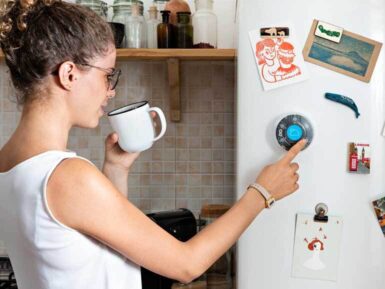
Grove - Temp & Humi & Barometer Sensor (BME280)
Grove - Barometer Sensor (BME280) is a breakout board for Bosch BMP280 high-precision, low-power combined humidity, pressure, and temperature sensor.
Overview
This module can be used to measure temperature, atmospheric pressure and humidity accurately and fast. As the atmospheric pressure changes with altitude, it can also measure approximate altitude of a place. It can be connected to a microcontroller with I2C (integrated with Grove socket) or through the SPI bus. There is also provided highly abstracted library to make the product easier to use.
The BME280 is an upgraded version of BMP180, and BME280 gets dramatic improvements from BMP180. BME280 comes with a smaller footprint, lower power consumption, lower noise measurements, higher resolutions for pressure and temperature, lower RMS noise, newly added SPI bus, more measuring modes, higher measuring rate, and newly added filter against environmental interference. Since the atmosphere pressure reading is affected by altitude and temperature, we have added compensation features.
Hence, Grove - Barometer Sensor (BME280) will be more reliable in providing precise temperature, atmospheric pressure values, humidity and approximate altitude data.
Features:
- Get more precise temperature, atmospheric pressure values, humidity and approximate altitude data fast.
- Grove compatible for ease to use
- Highly abstracted library for building projects quicke
Tech specs
|
Parameter |
Value |
|
Input voltage |
3.3V or 5V |
|
I/O voltage |
3.3V or 5V |
|
Operating current |
0.4mA |
|
Operating temperature |
-40 - 85 ℃ |
|
Atmospheric pressure sensor measurement range |
300 - 1100 hPa (1 hPa= one hundred Pa) with ±1.0 hPa accuracy |
|
Temperature sensor measurement range |
-40 - 85 ℃, with ±1.0°C accuracy |
|
Humidity sensor measurements range |
0% - 100% relative humidity , with ±3% accuracy |
|
Measurement modes |
Piezo & Temperature, forced or periodic |
|
Chip |
BME280(datasheet) |
|
Interface Bus |
SPI, I2C (use either one of them) |
|
Weight |
3.2 g (for breakout board), 9.3 g for whole package each piece |
|
Dimensions |
40 (length) × 20 (width) mm |
Note:
The altitude is calculated by a combination of temperature and atmospheric pressure. There is no specialized components for altitude measurement.
Get Inspired
Weather forecast for 7 days and current (local) weather data displayer using the Arduino Opla IoT Kit

We’re excited to announce the launch of the Arduino Oplà Kit, the first open programmable IoT platform that allows you to add smart connectivity to the devices around your home or workplace and build custom IoT devices. The Oplà IoT Kit contains all the hardware necessary to create eight connected applications, access to an online platform with assembly instructions, and a 12-month subscription to the Arduino Create Maker Plan. This kit is perfect for beginners with basic DIY experience, while more advanced users can leverage it to customize and hack their smart applications and devices, with full control of their data and processes. Eight out-of-the-box projects to connect your home or workplace The projects included in the Oplà IoT Kit enable users to turn everyday appliances into smart appliances, which can be controlled remotely on a mobile phone: Remote Controlled Lights — Change color, light modes, and switch on/offPersonal Weather Station — Record and monitor local weather conditionsHome Security Alarm — Detect motion and trigger warningsSolar System Tracker — Retrieve data from planets and moons in the solar systemInventory Control — Track goods in and outSmart Garden — Monitor and manage the environment for your plantsThermostat Control — Smart control for heating and cooling systemsThinking About You — Send messages between the kit and the Arduino IoT Cloud Create, connect, control. The Internet of Things has never been so easy! No soldering is required with the Oplà IoT Kit, which is based on a MKR IoT carrier with an OLED color display, on-board environmental sensors, and capacitive touch buttons. The kit also includes a MKR WiFi 1010 board, a circular plastic enclosure and supporting accessories, such as two cables, a motion sensor, a moisture sensor, and a USB cable. To build applications, users can rely on the Oplà online platform. Each project includes goals, an intro to the components,








